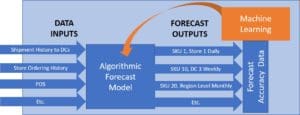Artificial intelligence (AI) is hot. Crunchbase reported that over the last year over $4 billion in venture capital has been invested in AI firms just in the US. In the supply chain realm, the branch of AI known as machine learning is where most of the activity is, particularly for software suppliers offering supply chain planning (SCP) applications. Arnaud Hedoux, the Director of Marketing for Demand & Supply Chain Planning Solutions at Dynasys, a QAD company, made the point that “The adoption of machine learning is the key driver in the ‘arms-race’ between software vendors to achieve differentiation.”
Supply Chain Planning has long been an application that has relied on Ph.D.s in operations research (OR) or statistics to build the math that powers these applications. Thus, few planning supplies are buying third party machine learning technologies to embed in their solutions. The planning vendors have built, and are building, machine learning solutions into their SCP applications.
But what is machine learning? Some of the SCP companies I talk to have been too modest in taking credit for their activities in this area. If they can’t label their solution as being based upon a computational technique generally associated with machine learning, they are apt to say their solution has “characteristics” of machine learning, but is not truly a machine learning application.
I think they are being too modest.
Adeel Najmi – the Senior Vice President for Products at One Network Enterprises, who holds a doctorate in Industrial Engineering and Operations Research from Berkeley – agrees. “Learning occurs when a machine takes the output, observes the accuracy of the output, and updates its own model so that better outputs will occur. Any machine that does this is using machine learning. It doesn’t matter if data science methods are used or not. It does not matter if neural networks or some other form of supervised or unsupervised learning technique is being used. It’s important not to get bogged down on the specific technique. What matter is if the machine is itself capable of learning and improving with experience.”

By this definition, when it comes to demand planning, some companies, like JDA, have been applying machine learning to demand forecasting long before AI became hot. JDA figured out how to let the machine automate this process, over a decade ago. Today, several other supply chain solution providers are doing the same thing.
Over time, many more data inputs have been introduced into the demand planning process, and many companies are doing far more forecasts. For example, instead of just doing a monthly forecast in the eastern half of the country, some companies are doing forecasts at the product/store level at daily, weekly, monthly and longer time frames. For a product being forecast daily at the store level, it may be that algorithms applied to the POS data stream have the most predictive power. Forecasting that same product at the warehouse level on a monthly basis, an algorithm applied to warehouse shipment history and warehouse ordering patterns has more predictive power. A forecasting engine with machine learning, just keeps looking to see which combinations of algorithms and data streams have the most predictive power for the different forecasting hierarchies. When if finds it can improve the forecast, it either changes the model or suggests to the planner that the model should be changed in a specific way.
The new AI startups are looking for customers with novel problems they can work on. Interestingly, the established planning companies are finding themselves pulled into machine learning projects from their established customers. As one example, Sujit Singh, the Chief of Operations at Arkieva, explained to me how they were now using machine learning techniques to predict which production machines were likely to break down based on the length of the product run, count of unique products being produced and the specific products that ran on particular machines, to improve production planning. On the demand front, Arkieva is taking market basket analytics, historically something retailers did, and applying these techniques to improving demand plans for business to business companies.
In short, supply chain planning software companies, with their cadre of operations research Ph.Ds who have been modeling complex problems for decades, may be better poised to solve many complex business problems than the hot new Silicon Valley firms.


















Leave a Reply